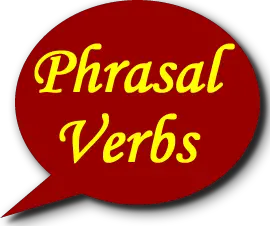Frequently Used Phrasal Verbs With Examples
 GRAMMAR
GRAMMAR
Phrasal verbs
 What are phrasal verbs?
What are phrasal verbs?
Phrasal verbs are phrases that indicate actions. They are generally used in spoken English and informal texts. Examples of such verbs include: turn down, come across and run into.
Phrasal verbs consist of a verb and a preposition or an adverb:
| Verb | Preposition/adverb |
|---|---|
| get | up |
| go | through |
| write | down |
| take | after |
Sometimes phrasal verbs consist of three elements:
| Verb | Preposition / adverb 1 | Preposition / adverb 2 |
|---|---|---|
| look | forward | to |
| put | up | with |
| sit | in | for |
When added to the verb the preposition or adverb may change completely the meaning of the verb. Here are some examples:
| Phrasal verb | Meaning | Example |
|---|---|---|
| look for | search/seek | He is looking for his keys |
| look up to | have a great deal of respect for a person | His father is his model. He is the person he looks up to. |
| look forward to | await eagerly/anticipate with pleasure | She is looking forward to visiting Paris. |
| look up | to try to find a piece of information by looking in a book or on a computer: | She didn't understand the word. So she looked it up in her dictionary |
The meaning of phrasal verbs
Sometimes, it is difficult to understand the meaning of phrasal verbs. Before looking them up in a dictionary, it would be helpful to use the context to understand them.
Literal meaning
Some phrasal verbs have a literal meaning. They can be easily understood.
- She opened the door and looked outside.
- She was walking across the street when she heard the sound of an explosion.
Idiomatic meaning
Phrasal verbs can also have a figurative or idiomatic meaning which makes them difficult to understand.
- Can you put me up for tonight?
The phrasal verb 'put up' here does not mean to build (as in putting a fence up). It has, however, an idiomatic/figurative meaning. It means to let someone stay in your house.
Separable or inseparable?
1. Sometimes, the preposition/adverb is placed either after the verb or after the object.
Examples:
- Mary made up a really entertaining story.
- Mary made the story up .
2. If the object is a pronoun, however, the preposition/adverb has to be placed after the pronoun (object).
Examples:
- She made it up .
- Put it down.
- Take it off.
3. Some phrasal verbs are always inseparable.
Example:
- I came across some old photos in a drawer.
NOT
-
I came some old photos across in a drawer.
Frequently used phrasal verbs
This is a list of phrasal verbs and their meaning arranged in alphabetical order:
Recommended books
Quick Links
Awsome Links You May Like
-
A List of Idiomatic Expressions
What are idioms? And how can idioms help you become a fluent speaker? Discover a list of the most widely used idiomatic expressions!
-
A list of Phrasal Verbs
Phrasal verbs are generally used in spoken English and informal texts. Check out our list of hundreds of phrasal verbs classified in alphabetical order.
-
A list of figures of speech
Do you want to provide emphasis, freshness of expression, or clarity to your writing? Check out this list of figures of speech!
-
A list of irregular verbs
Do you need to learn the irregular verbs in English? Here is a list of irregular verbs with definitions and examples!
Frequently Used Phrasal Verbs With Examples
Source: https://www.myenglishpages.com/english/grammar-lesson-phrasal-verbs.php
0 Response to "Frequently Used Phrasal Verbs With Examples"
Post a Comment